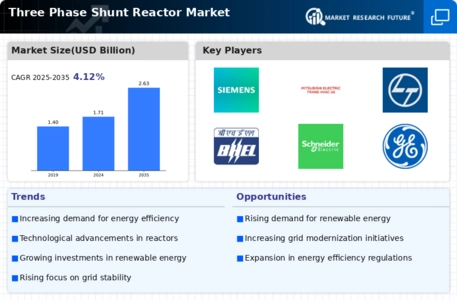Growing Need for Voltage Regulation
The increasing complexity of electrical grids necessitates effective voltage regulation, which is a primary function of the Three Phase Shunt Reactor Market. As power systems evolve, the demand for devices that can mitigate voltage fluctuations becomes paramount. This is particularly relevant in regions experiencing rapid industrial growth, where the integration of various power sources can lead to instability. The market for three phase shunt reactors is projected to expand as utilities seek solutions to maintain voltage levels within acceptable limits. In 2025, the market is expected to witness a growth rate of approximately 6% annually, driven by the need for enhanced voltage control in transmission networks.
Expansion of Transmission Infrastructure
The ongoing expansion of transmission infrastructure is a critical driver for the Three Phase Shunt Reactor Market. As countries invest in modernizing their electrical grids, the need for efficient power transmission becomes increasingly evident. Shunt reactors play a vital role in managing reactive power and ensuring the stability of long-distance transmission lines. In many regions, the construction of new transmission lines is accompanied by the installation of shunt reactors to counteract the effects of capacitive loads. This trend is expected to contribute to a market growth of around 5% in the coming years, as utilities prioritize investments in reliable and efficient transmission systems.
Regulatory Support for Energy Efficiency
Regulatory frameworks aimed at promoting energy efficiency are emerging as a significant driver for the Three Phase Shunt Reactor Market. Governments worldwide are implementing policies that encourage the adoption of technologies that enhance grid efficiency and reduce energy losses. Shunt reactors, by providing reactive power support, contribute to the overall efficiency of power systems. As regulations become more stringent, utilities are likely to invest in shunt reactors to comply with energy efficiency standards. This regulatory push is expected to result in a market growth rate of around 4% as utilities seek to align with governmental mandates and improve their operational efficiency.
Rising Adoption of Smart Grid Technologies
The transition towards smart grid technologies is significantly influencing the Three Phase Shunt Reactor Market. Smart grids facilitate better monitoring and management of electricity flow, which in turn enhances the need for reactive power compensation. Shunt reactors are integral to this process, as they help maintain voltage stability and improve overall grid performance. The increasing deployment of smart meters and advanced grid management systems is likely to drive demand for shunt reactors, with market analysts predicting a growth trajectory of approximately 7% over the next few years. This shift towards smarter energy solutions underscores the importance of integrating shunt reactors into modern grid systems.
Increased Investment in Renewable Energy Sources
The surge in investment in renewable energy sources is a pivotal factor influencing the Three Phase Shunt Reactor Market. As more renewable energy projects come online, the need for reactive power management becomes critical to ensure grid stability. Shunt reactors are essential in balancing the intermittent nature of renewable energy generation, particularly from wind and solar sources. The market is anticipated to grow by approximately 8% as utilities and energy producers recognize the necessity of integrating shunt reactors into their systems to accommodate the increasing share of renewables. This trend highlights the essential role of shunt reactors in facilitating a sustainable energy future.


















Leave a Comment